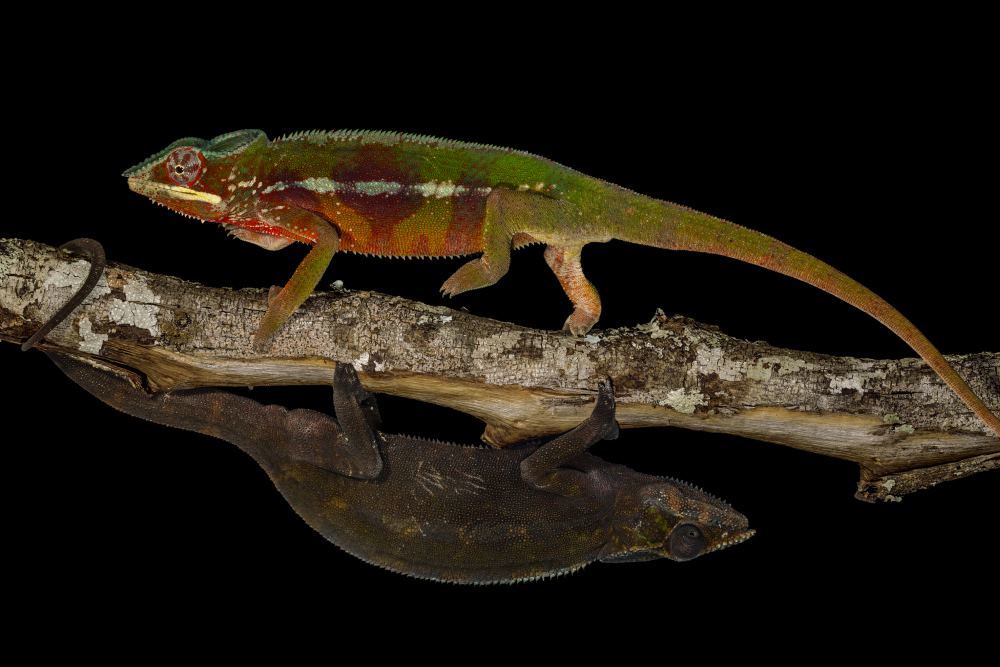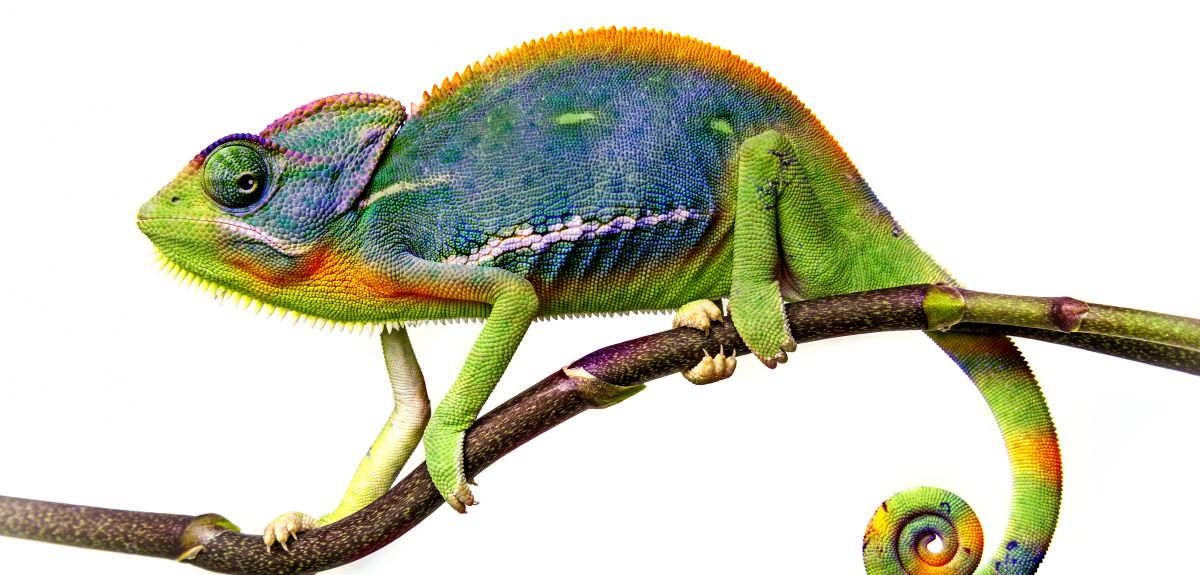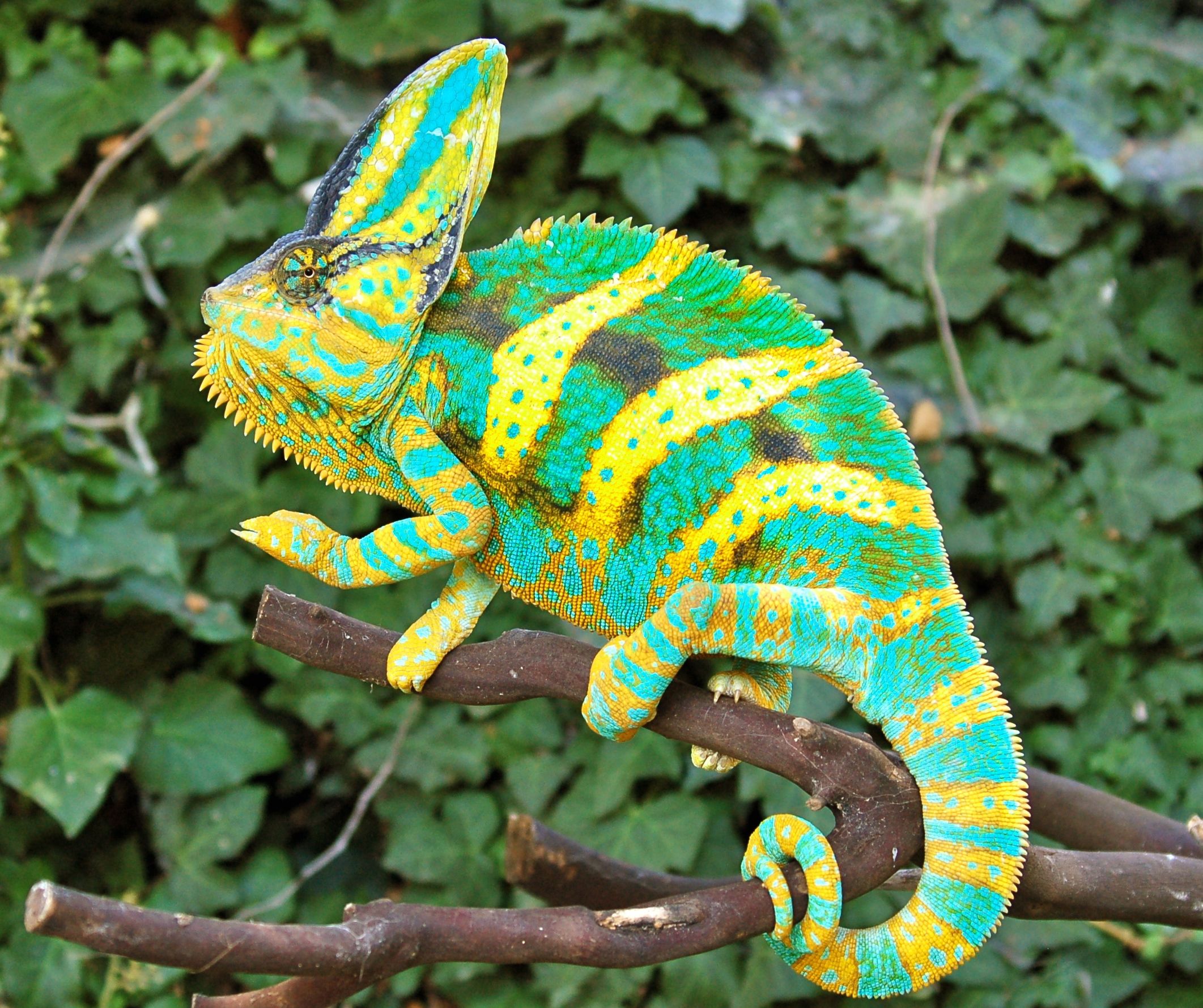Physics in the animal world: chameleons and their color

Source: National Georaphic
Chameleons are very unusual animals. They are distinguished by the way of nutrition, the system of vision, and the ability to change the color of the body depending on various factors. Previously, scientists believed that the chameleon had developed a way to disguise itself as its environment, protecting itself from predators. In fact, the skin color of the chameleon changes depending on the air temperature, light, mood, and physiological processes occurring in the body (for example, the pregnancy of the female).
How does an animal change skin color? Scientists have long figured out that the reason is in the pigment cells called chromatophores. These cells are translated from the Greek as "carrier-colored". The principle of their work is rather complicated. Each such cell contains pigments in the cytoplasm that allow the skin of the animal to change its color. The main pigment cells of chameleons are melanocytes and melanophores, which contain various modifications of melanin in specific organelles (melanosomes). Then come the xanthophors, which contain carotenoids, flavins and pteridines, containing color gamut pigments from yellow to red.
These pigments are located in other organelles, called pterinosomes. They are also in a free state, in the form of drops, being located in the cytoplasm. There are also iridocytes or guanofors that contain guanidine crystals. These crystals provide a silvery or golden color. Under pressure and exposure to chemical compounds, crystals can change their location . With an increase in the distance between them, the spectrum of the color reflected by the skin also changes. The higher the gap, the higher the shift from the blue part of the spectrum to the green and then to the red.
')

How it works?
Chromatophores for the most part are the most deep and fibrous layer of the animal's skin. These cells contain pigment grains, as mentioned above. Moreover, in some chromatophores of pigment grains more than in the rest. The location of the pigment in such a cell also matters. It can be evenly distributed throughout the cell, it can be located in its ramifications or directly in the center. A special feature of chromatophores is that pigment grains can move through such a cell.

Source: National Georaphic
If the processes of chromatophores are reduced, the pigment grains begin to concentrate in the center of the cells. In this case, the skin of the chameleon looks whitish or even yellow. If chromatophores are distributed along branches of the chromatophore, the skin becomes dark, sometimes black. Shades of chameleon skin are caused by mixing the pigments of both layers. Green tones characteristic of the animal arise when the sun's rays are refracted in the surface layer. Here guanidine crystals are distributed, which refract rays. As a result, a chameleon can quickly change its color, changing shades from whitish to orange. Interestingly, the changes can capture only a part of the chameleon’s body, and can affect its entire body, from the muzzle to the tip of the tail. Chromatophores, besides other possibilities, “are able” to change the depth of occurrence in the skin. The higher the depth of placement of the chromatophore, the paler the skin. The brighter - so it is more contrast.
Why does a chameleon change its color
This is influenced by many factors. Their scientists are divided into two groups. The first group - purely physiological factors, is the ambient temperature, lighting, humidity, hunger, dehydration, pain. The second group is the emotional factors. This includes fear, pleasure, annoyance, and everything else. During the mating season, male chameleons react to one another, changing colors to brighter ones when an opponent approaches. Females also react, and the pregnant female has a different color than the normal female.
It has already been said that masking is not a priority for a chameleon. But it so happened that the chameleon takes the color of the place on which it crawls. This is not always the case, but it often happens that way. And if the optic nerve of an animal is damaged, it will lose its ability to change color. For many years, scientists have conducted many experiments with chameleons. A large number of observations. Among them the most interesting are the following:
- A chameleon with a damaged optic nerve loses its ability to change its color. If the nerve is damaged in one of the eyes, then the skin on the corresponding side of the animal’s body brightens;
- If the chameleon’s spinal cord is irritated with a current, the body becomes brighter; if the spinal cord is removed, the skin darkens;
- If the chameleon is euthanized with ether, the animal becomes brighter, if the same operation is carried out with chloroform - the animal's body becomes darker;
- If the central optic nerve is irritated by a current, the chameleon’s body becomes darker.

Scientists studying chameleons have suggested that the skin color of a chameleon is controlled using two types of centers in the central nervous system of a chameleon. The first type can be called "volitional", the second - purely automatic. The second type of centers support the color-changing system in a certain tone. These centers are influenced by "volitional" centers that suppress the action of automatic centers. The first cause darkening, the second - the enlightenment of the skin.
Source: https://habr.com/ru/post/399825/
All Articles